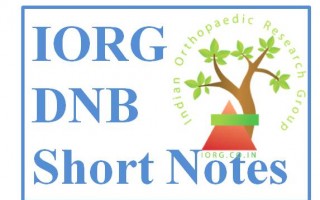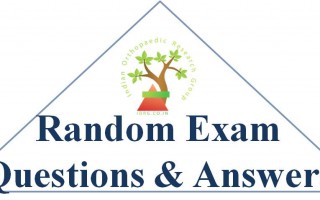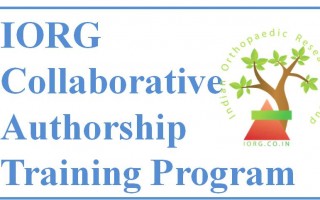What is Ward’s triangle or Babcock’s triangle?
Wards- Lateral to principle compression & below tension trabeculae this area is rarely avoided fixation
Babcock’s- Inferior center of head where implant fixation is poor.
What reduction will you prefer, varus or Valgus alignment?
Valgus alignment – As it is responsible for controlled collapse & reduces bending movement by shear.
Who discovered Bipolar prosthesis?
James Batman.
Define Perthes Disease?
It is a self limiting disorder of unknown etiology characterized by avascular necrosis of the capital femoral epiphysis.
What is the aim of treatment of Perthes Disease?
The aim is to prevent late secondary osteoarthrosis of the hip. The disorder is self limiting with revascularization occurring over a period of two years. the treatment is aimed at preventing or reducing the deformation of the epiphysis.
What are the morphological changes in the Femoral Head commonly associated with Perthes Disease?
Coxa Irregularis (irregularly shaped femoral head),
Coxa Magna (large femoral head, as compared to other normal side of not contained in acetabulum as seen by acetabular index) or
Coxa Breva (short femoral neck) with trochanteric overgrowth.
What factors determine the development of Osteoarthrosis in Perthes Disease?
Stulberg and Salter Noted two long term prognostic factors: age at onset and shape of femoral head at the time of revascularization. They also reported short term prognostic factors: age at onset, extent of epiphyseal avascularity, persistent loss of hip movement and Epiphyseal Extrusion. Epiphyseal extrusion is the factor that can be altered by active treatment.
What are common named tests for Acute shoulder dislocation?
Duga’s Test: Patient is asked to touch the hand of the affected shoulder to the opposite normal shoulder. The Patient is then instructed to touch the elbow to the chest. in case of shoulder dislocation or subluxation, patient will not be able to do so and DUGA’S test is said to be positive
Callaway’s test: Dislocated shoulder has increased Girth
Bryant Sign: lowering of axillary fold is suggestive of dislocation.
Hamilton’s Ruler Test: in normal shoulder joint, the contour of the shoulder prevents placement of a straight ruler touching the acromion and the lateral epicondyle. In cases with shoulder dislocation the contour of the shoulder is lost and ruler can be placed laterally touching both the acromion and the lateral epicondyle
\What does Square pelvis mean?
The line Joining the ASIS is normally at a right angle to the midline of the body [spine] and in this position the pelvis is said to be in conformity with the plain of the spine or as pelvis is square with respect to the spine.
What are test used to examine hip stability?
Trendelenberg Test [in standing position] Telescopic Test [in Supine Position]
What clinical findings support your diagnosis of Peroneal Spastic Flat foot?
Following clinical finding support my diagnosis:
Restricted Subtalar Motion
Hindfoot Valgus Deformity
Abduction of the Forefoot
Tightness of the Peroneal Tendon
Define Vertical Talus?
Congenital Vertical Talus is defined as dorsolateral dislocation of the talo-calcaneo-navicular Joint, clinically presenting with rocker-bottom foot having convex plantar surface and classic radiological appearance of vertically oriented talus which is almost parallel to tibia on lateral projection.
What is an Oblique Talus?
It is a less severe variant of CVT where the child has rocker bottom foot with equinus of the hindfoot, but the navicular can be reduced over the talus head on plantar flexion. Thus here the dislocated talus is not locked by the dorsally ‘blocking’ navicular as seen in CVT. This has a better prognosis and responds well to non surgical treatment
What is the incidence of Accessory Navicular?
12-26%
Define Congenital Coxa Vara?
It is a developmental anomaly characterized by primary cartilaginous defect in the femoral neck with decrease in neck shaft angle, short femoral neck, overgrowth of trochanter and overall shortening of the limb
What is the recovery Rate by neurolysis or nerve repair in brachial plexus injuries?
for Supraclavicular BP injury - 85%
for infraclavicular BP INJURY- 55%
For long thoracic nerve- do not repair, reconstruction is adviced if no recovery in 9-12 months
For axillary nerve- no statistical data vailable on recovery
For radial nerve injury- 89%proximal muscle recovery
63% useful function in all muscles [more than grade 3]
36% regain fine control of extensors of the finger and thumb
For ulnar nerve injury- 50% recover useful long flexor power
5% interosseous function
78% recover useful motor function
For median nerve injury - 90% good long flexor recovery
2/3rd have good thenar muscle function
What are bone tumors common in females?
remembered by pneumonic 'Goa' - Giant Cell Tumor, Osteogenic sarcoma (parosteal) and Aneurysmal Bone Cyst
What are the three generations of cementing techniques in Total Joint replacement?
First Generation: the cement was mixed manually with manual insertion of the cement in to the femoral canal. The cancellous bone is not removed completely and no additional measures to dry the canal. A vent is used in this technique but no distal plug
Second generation: Pulse lavage and drying of the canal by packing with adrenaline soaked gauze (or cold saline). Cement is injected in retrograde fashion using a cement gun. All the cancellous bone is scraped out of the canal till almost the endosteum and a distal cement restrictor is used
Third generation: vaccum/centrifuge mixing of the cement: retrograde injection of the cement with pressurization. Distal and proximal stem centralizers are used to achieve a even cement mantle and to get a neutral stem position. Cement precoating of the implant is also done. This is in addition to all the steps of second generation cementing technique including cement restrictor, pulse lavage, scraping of all cancellous bone, packing an drying of canal by use of adrenaline soaked gauze.
What is the rationale behind the 2nd and 3rd generation cementing techniques?
The 2nd generation cementing is aimed at improving the cement bone interface and thus more stress on complete removal of all the calcellous bone from the canal walls, pulse lavage and drying the canal. The third generation cementing is aimed at improving the cement metal interface and so more stress on good cement mixing and centralizing the stem.
For Random Exam Questions and Answers (REQA) part II - CLICK HERE













 India-Orth
India-Orth